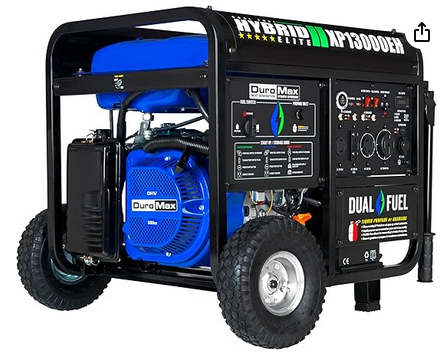The weather hasn’t been good for solar recently. We’ve had enough to run the house without compromise, including a couple of loads of laundry. There hasn’t been much left over to charge Joulee the Free Salvage Tesla, however.
Our guests are flying out in the morning, and HA wanted to take Joulee instead of Timmy the Titan to the airport. It was also time for a thorough test of our backup generator. Three years ago, I bought a big dual-fuel generator (DuroMax XP13000EH) so that we would have emergency power for our mainland home, knowing that I’d likely end up off-grid and need a backup device. Propane fuel is nice for such applications, as it’s easier and safer to store than gasoline and less likely to gum up carburetors when it sits unused for a while.

We took the kids sightseeing in the morning, and of course it was raining when we got back in the afternoon. The backup generator is out by the studio, so I was glad that I had a path to get out to the studio when everything was soaked. Here is what happened:
-
The starting battery was dead. Since I test run the generator every 90 days, that really shouldn’t happen. On the other hand, it’s 3 years old so perhaps it’s just due for a replacement. I’ll put a charger/conditioner on it first to see if it can be salvaged, but not while it’s raining. I had to start it with the rope starter, which is no small thing on a beast this size.
-
It started out working fine, but then got wonky. The inverter would stop taking power from the generator. You could hear its load lighten and of course I was monitoring it on my computer. I made a couple of trips (in the rain) to see what was going wrong, but apparently it was just the inverter not liking the quality of the power from the generator. It would re-set on its own, so it was in fact charging the house most of the time. So I decided to just let it run.
-
I started charging the car, and the inverter started rejecting the generator power more often. Then the generator power dropped out completely, and another slog out to the studio showed that the breaker on the generator had tripped. Apparently the maximum load the inverter is set to draw is too high. I reset the breaker.
-
I tried limiting the charge current to the car. A lot. That kept the breaker from tripping, but the inverter still stopped taking current from the generator every few minutes, and it would take a minute or so for the generator to come back on line, so we weren’t being very efficient.
-
Then the generator output voltage dropped a lot (to about 130v from nominal 240v) and it started sounding rough. I carted a 5 gallon can of gasoline over my new trail (would have been awful before) and discovered what I suspected: the propane was very low. When this generator runs out of gas, it simply stops. Apparently, when the propane runs low, things degrade slowly but not gracefully.
-
I switched the generator to gasoline, and it started running much better and the inverter was much happier with it. Apparently, it just doesn’t run very well on propane and the resulting AC power was just too variable to keep the inverter happy.
-
Now that I was getting stable charging of the house batteries, I tried charging the car again. The inverter held, but the car kept stopping its charging then starting over, ramping up the charge current from zero. It wasn’t doing too well.
This is a classic case of something working great in testing, but failing in multiple ways in a more real-world scenario. We learned that it really doesn’t work with propane, which is too bad because I don’t expect to have to use the generator often at all, and I’ll have to be diligent about running it every month if I want to keep it working with gasoline.
I need to figure out how to program the inverter to not take so much power from the generator. It’s advertised as 13,000 watts, but manufacturers always advertise surge power. Continuous running power is 10,500 watts on gasoline and 9,975 on propane. That is really optimistic. To get the power to be clean enough, it looks like I’ll have to limit draw to 6,000 watts or so (generally more energy efficient and better for longevity anyway). I’m hoping at that level, the power will stay clean enough that the car will charge properly (if a bit slowly).
Another reminder that one must do comprehensive testing of backup systems.
—2p